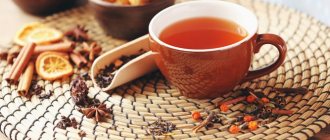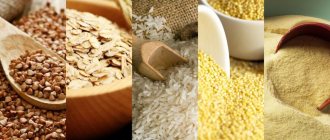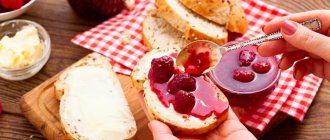Many mothers are sure that the range of dishes for a nursing woman is quite poor. All food seems monotonous, and sometimes not even tasty. In fact, in almost every category of products you can find an exception - what is allowed to eat while guarded. The same applies to sweets - one cannot assume that eating sweets is contraindicated when feeding a baby. And to the question of mothers “what to drink tea with while breastfeeding?” you can easily find the answer. By following simple rules when choosing sweets, a nursing mother will not harm herself or her baby.
Sweets are not contraindicated during breastfeeding, but you should not eat everything, carefully choosing what to eat and in what quantity.
Why do you want to constantly eat sweets and starchy foods during breastfeeding?
Breastfeeding is a complex and energy-consuming process for a woman’s body. Hundreds of calories are spent every day producing breast milk. Since the body is structured as a single system, it constantly requires carbohydrates to replenish its reserves of strength and energy.
There are complex (slow) and fast carbohydrates. Complex carbohydrates can be obtained, for example, from cereals. Fast carbohydrates are sweets and flour. They break down faster, releasing energy. Since the body of a nursing woman constantly requires it, the mother feels the need to constantly replenish her energy supply immediately. It is these reasons that determine the constant craving for sweets and starchy foods. In addition, these products cause the synthesis of serotonin, the hormone of joy, which improves the production of breast milk.
How can you replace white sugar during lactation?
Some people argue that there are many healthy alternatives to regular white sugar. Let's look at the most popular ones.
Cane sugar
Cane sugar is obtained from sugar cane. This is a raw (unrefined) product. It has several varieties:
- demerra;
- cassonade;
- turbinado;
- muscovado;
- black Barbados.
Brown sugar is 3 times more expensive than regular white sugar, since all its varieties are produced in exotic countries. This type of sugar is as harmful to health as white sugar. But due to the fact that it is purified, trace elements are retained in it:
- zinc;
- iron;
- phosphorus;
- magnesium.
White and brown sugar have approximately the same calorie content - 400 kcal per 100 grams of product. White sugar consists almost entirely of carbohydrates (98%), with the remaining 2% being sodium and calcium. Brown sugar contains 96% carbohydrates, and its additional composition was described above.
Brown sugar contains 96% carbohydrates
During breastfeeding, the doctor recommended that I use cane sugar in my food. She said that it is healthier for adult children than white. This may be true, but it costs more, and the taste is no different from white. At the same time, it contains only 3% more nutrients than regular white, so I still ate my usual refined pieces.
Video: how to choose cane sugar
Fructose
Fructose is a natural sugar found in some fruits and vegetables. It has a number of advantages compared to others:
- Low calorie content: when consuming it, a nursing woman does not have to worry about adding new kilograms.
- Safety for tooth enamel.
- Low allergenicity, ability to enhance immunity.
- Compared to sucrose, it has a sweeter taste, so when it is consumed, it quickly saturates.
- Does not cause fluctuations in blood sugar, which is very important for diabetes.
Fructose is ideal for making sweet desserts (jams, preserves), which will retain freshness for a long time due to the good moisture retention of this type of sugar.
We recommend reading: Salads for breastfeeding
Fructose is ideal for preparing sweet desserts (jams, preserves), which will retain freshness for a long time due to the good moisture retention of this type of sugar.
Ready-made fructose is sold in the store. It can also be obtained with berries and fruits. Fructose is contained in honey, so if this product does not cause allergies in the baby, then it can easily replace sugar. A nursing mother should also take into account the negative effects of fructose:
- Consumption of more than 30 g of product per day can provoke disturbances in the functioning of the cardiovascular system, acid-base balance, and liver.
- Excessive consumption of fructose is dangerous if you have diabetes.
- The components of fructose are well absorbed by the body, so after a short period the woman feels hungry again.
The calorie content of fructose is 399 kcal per 100 grams of product. It contains 98% carbohydrates.
Where does fructose come from?
The most common and well-known natural sweetener today is fructose. How is it produced? Although this sweetener is a natural product, it is rarely found in free form in nature. This species can only be isolated from Jerusalem artichoke fruits and dahlia tubers. They are used to make sweetener in laboratory conditions. The fruits and tubers are boiled, mixed with sulfuric acid, and then the water is evaporated, thus producing fructose crystals. Most often, fruit sugar is found in bound form; it is inseparable from other substances. This is a more difficult way to obtain sweetener. In production, sucrose is broken down using chemical reactions and two independent substances are obtained: fructose and glucose.
Beneficial features
Nursing mothers have to adhere to a certain diet, the severity of which depends on the age of the baby, the maturity of its digestive system and predisposition to allergies.
Sugar from food passes into breast milk; its excess is dangerous for the baby because:
- causes fermentation in the intestines, increased gas formation, bloating;
- disrupts the functioning of the endocrine system;
- destroys the enamel of children's teeth.
For this reason, it is recommended to limit the consumption of sweets and other sugar-containing foods while breastfeeding. Artificial sweeteners are also contraindicated - they can be toxic, cause allergies, and negatively affect the growth and development of the baby. Natural fructose, extracted from fruits and berries, is one of the safest sweeteners.
If a nursing mother has an unbearable craving for sweets, she can be advised to eat some fructose-based jam or preserves made from foods to which the baby’s body has managed to adapt. By adding this sugar substitute to the dough, you can get fluffy, soft baked goods. Another property of the monosaccharide is its ability to enhance flavors, making dishes with fruits and berries more appetizing.
Fructose gives the body energy, increases resistance to physical and mental stress, reducing fatigue. Using a monosaccharide instead of sugar helps relieve nervous tension and fight stress during the postpartum period.
Since the breakdown of fructose does not involve insulin, replacing sugar with this monosaccharide reduces the load on the pancreas and helps normalize carbohydrate metabolism in the body.
Another advantage of a sweetener is the absence of a negative effect on tooth enamel. Eating sweets will not lead to the formation of plaque on the teeth and the development of caries.
Negative Impact
Fructose is considered a suitable sweetener for nursing mothers who want to improve their figure after childbirth and lose excess weight. This is due to the low calorie content of the monosaccharide compared to regular sugar. However, it is fructose that can lead to obesity if you abuse foods that contain it.
Metabolism of fructose is carried out in the liver, and unclaimed carbohydrates are directly converted into fatty acids, enter the blood and from there into the adipose tissue of the body.
This is why fructose-containing foods should not be consumed during a diet aimed at losing weight. In addition, excess fatty acids in the blood lead to disruption of the cardiovascular system. Abuse of monosaccharide is dangerous for the body.
We recommend reading: Green tea during breastfeeding: is it possible or not?
A nursing mother should avoid products containing artificially produced monosaccharides. Systematic consumption of freshly squeezed juices is also harmful, since the drink does not contain coarse fiber, which slows down the breakdown of carbohydrates - in this case, the bloodstream receives a “load dose” of fructose processing products.
Stevia
Stevia is a sweet herb native to South America. An aqueous sweet extract is produced from it, and the leaves of the plant are used for this. The herb has many types, but honey stevia is the most popular in the industry. It is used to produce food supplements and products intended for people suffering from obesity and diabetes.
This natural sweetener comes in the following forms:
- soluble tablets;
- syrup obtained by boiling an aqueous extract, added to food in drops;
- concentrated powder (stevoside) added to food and drinks at the tip of a knife;
One of the forms of stevia release is concentrated powder. - herbal tea in the form of filter bags, brewed using boiling water.
Stevia products are more expensive than white sugar. However, it has a number of advantages:
- does not raise blood sugar levels;
- helps lower blood pressure;
- normalizes digestion and does not cause heartburn;
- helps strengthen the heart;
- eliminates the development of arthritis and kidney diseases by reducing the concentration of uric acid in the body;
- does not increase weight.
A nursing woman should also take into account the negative effects of the product:
- risk of allergies;
- contraindication for hypotension;
- the possible occurrence of hypoglycemia (a drop in blood glucose levels to a critical level) due to frequent use of the product;
- the appearance of dizziness and nausea, pain and numbness in the muscles due to individual intolerance to the plant.
The calorie content of stevia is 272 kcal per 100 grams of product. It contains 13% carbohydrates.
Healthy sweets
It’s not just sugar that can be sweet, no matter how banal it may sound. And the restriction on candy, baked goods and other sweets is not the biggest sorrow. After all, you always have complete natural sweet foods on hand, filled with a fair amount of vitamins and minerals.
So, if the baby does not have allergic reactions, you can replace sugar with honey (of course, in moderation, because honey contains pollen, a strong allergen). Seasonal fruits will also bring mom a lot of taste pleasures, and most importantly, benefits.
It is worth giving preference to fruits that grow in the area where the young mother lives. It is better to put off exotic fruits and citrus fruits and introduce them into the diet as the child grows older.
Fruits and berries are natural sources of fructose.
If a nursing mother eats a lot of sweets, how does this affect the baby?
The diet of a nursing mother directly affects the baby. If a mother eats something harmful, in rare cases it does not provoke negative symptoms in the child. The same goes for sweets. In small quantities, good quality natural sweets will only bring benefits. But if you eat too many of them, a woman’s body will become oversaturated with carbohydrates. This can cause excessive stress on the baby’s gastrointestinal tract, which leads to colic, stool disorders, increased gas formation, etc.
In addition, such products contain a lot of sugar and other substances that in large quantities can provoke an allergic reaction in a child. It can manifest itself in the form of rashes, itching, spots and other typical symptoms.
Can a child get fat?
If a nursing mother loves sweets, this is primarily harmful for her, especially for her figure. A large amount of carbohydrates leads to rapid weight gain. These calories are not transferred to the child, so it is illogical for the mother to eat a lot of sweets so that the baby gains weight. Carbohydrates do not increase the fat content and nutritional value of mother's milk so much that it affects the baby's weight. They are not distributed between mother and baby. Consequences for the child can only manifest themselves in the form of tummy problems or allergies.
Harm and use during hepatitis B
Among the disadvantages, we will immediately highlight the caloric content and allergenicity of the dish. Sugar and chicken eggs included in the recipe can provoke a severe allergic reaction in infants. In addition, a sweet dessert can cause digestive disorders, abdominal pain, and bowel problems in both mother and child.
Therefore, when breastfeeding, it is recommended to start eating such dishes only in the third month of feeding. By this time, the baby’s body has already adapted to new conditions and reacts more easily to such food. In addition, it is important to follow the dosage. It is advisable for nursing mothers to eat no more than two small meringues at a time, no more than twice a week.
It is better to exclude store-bought meringues and cakes from your diet altogether, as they contain a large number of chemical additives, flavors, dyes, and so on. This is extremely harmful for lactation and a small child. It is advisable to prepare desserts at home.
Do not overeat cakes, as a large amount of sugar will negatively affect your health. Excess sugar leads to problems with teeth and skin, and breast milk production. This can cause diabetes and obesity, disrupt metabolism and disrupt the functioning of the pancreas
The calorie content of meringue is 285 kcal per 100 grams. This is not very much, so if you follow the dosage, the treat will not affect your weight. By the way, it is one of the ten lightest desserts that do not harm your figure. Of course, when overeating, extra pounds cannot be avoided. How to lose weight quickly and without harm while breastfeeding, see here.
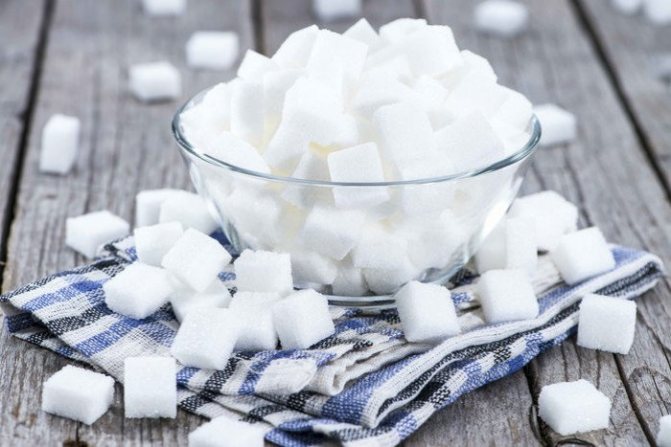
When and why should you not eat sweets while breastfeeding?
Not everyone is allowed to eat sweets while breastfeeding. It is not recommended to introduce it into the diet in the first months of breastfeeding, as it can cause allergies or tummy problems in the baby. During this period, it is better to replace sweets with more gentle products. Eating sweets is not recommended for mothers of children suffering from allergies or diathesis.
Can sweets cause colic?
Sweets contain a lot of carbohydrates. Consuming them in large quantities negatively affects not only the gastrointestinal tract of the mother, but also the baby. After all, digesting them is difficult for the body and can cause bloating, stool problems, colic, etc. Moreover, it is forbidden to eat sweets if you have colic. They can make the problem worse.
Why are sweets harmful to nursing mothers?
Sweets can harm not only the child, but also the mother. It is very high in calories, therefore, if consumed frequently, it leads to weight gain in a nursing woman. In addition, sweets have the following contraindications for consumption and harmful properties:
- obesity;
- diabetes;
- deterioration of teeth;
- metabolic disorder, etc.
How long does it take for sweets to be removed from breast milk?
Breast milk contains all the ingredients from the food that the mother has eaten. Sometimes a woman cannot restrain herself and eats foods to which the child is allergic or has another negative reaction. After this, you should not feed the baby. Therefore, the question arises, how much should you not feed after eating, for example, chocolate while breastfeeding?
The active substances from the mother’s food begin to enter the milk 20–30 minutes after consumption, and this continues for about a day if the sweets are natural. Chemical additives can take longer to digest, so they should not be eaten during breastfeeding.
What sweets should you not eat?
Despite the benefits of sweets for breastfeeding, not all treats are allowed for nursing mothers. Products with flavors, dyes and similar additives are prohibited. First of all, the list of forbidden foods includes sweet carbonated drinks, for example, the most common sweet water. They contain the largest amount of chemicals and sugar. But such products also include most store-bought candies, cakes, cookies, etc.
It is not recommended to eat cakes and pastries that contain rich cream, for example, eclairs with cream. This filling can cause colic, flatulence and constipation in the baby, as it is very difficult to digest.
It is not recommended to eat chocolate, especially with additives. The natural product contains cocoa, which is a strong allergen. Chocolate also contains a lot of sugar, which increases the risk of developing an allergic reaction. The presence of fillings, nuts, and dried fruits in the composition can also trigger allergies, so it is not recommended to consume chocolate with additives; it is better to choose regular chocolate.
What to replace sweets with?
If you decide to give up sweets during breastfeeding, but your body requires something similar, you can look for an alternative. Dried fruits are considered the best replacement for breastfeeding. A nursing mother should remember that not all dried fruits are allowed for breastfeeding from birth. In the first months it is best to eat dried apples, pears or prunes, and after 3 months it is allowed to introduce other dried fruits into the diet.
It is recommended to replace milk chocolate with black. You should not choose dark chocolate; it contains a high level of cocoa, which can cause excitability in the baby. Pastille, marshmallows and marmalade will be useful. These products are prepared from natural puree and juice, which will bring many benefits. Consider the fact that even these products can cause allergies. Pay attention to jelly made from homemade juice or compote. Powdered store-bought ones will not be beneficial, as they contain flavorings and dyes.
My rules of nutrition during breastfeeding.
Rules of PP for breastfeeding After the second birth, I decided that I would not listen to anyone about how much and what I needed to eat! I decided to immediately pull myself together and set myself the goal of losing weight to my weight by May!
12.If possible, keep a count of KBZHU.
For those who are interested, in the contact group, I will post my workouts and more)
Meringue is a mass of eggs and sugar or powdered sugar. After baking, it turns into an appetizing, light and tasty cake called meringue. However, the finished dessert is also called meringue. Both adults and children like this delicacy. It leaves a delicate and sweet aftertaste for a long time. By the way, it can act as a separate dessert or be included in cakes. Let's figure out whether a nursing mother can eat meringue.

TOP 12 sweets that nursing mothers can eat
Lactating women are constantly wondering what delicious things they can eat, because everything is prohibited. The most useful sweets for breastfeeding include the following:
- Pastila, homemade is best.
- Marshmallow: white, without dyes or flavors. Read more in the article “Marshmallows during breastfeeding.”
- Ice cream: organic white, no condensed milk, nuts, frosting, etc.
- Marmalade: natural, from organic juice, best homemade.
- Natural halva. The presence of large amounts of sugar is not recommended. It should be remembered that the seeds and nuts from which it is made can cause severe allergies.
- Condensed milk. Real condensed milk stimulates lactation and enriches the body with calcium, which is very beneficial for bones, teeth and nails.
- Homemade sweets. Creamy jellies or butterscotch (taffy) are best.
- Dried fruits. First of all, pay attention to dried apples, pears, prunes, and dried apricots.
- Meringue. The dessert consists of sugar and egg whites, so it is easy to prepare. Read more in the article “Merringue for breastfeeding.”
- Jam or marmalade is a delicious fruit treat that can be added to many confectioneries or baked goods. The safest representatives are apple, peach, and blueberry jam.
- Nuts or fruits in sugar. Fresh is best. Cranberries are considered the healthiest.
- Cookie. The safest are biscuits, long-lasting or children's cookies. They are allowed practically from the maternity hospital. Read more in the article “What kind of cookies can a nursing mother have.”
Composition and preparation features
The classic recipe includes only sugar and egg white. Instead of traditional sugar, vanilla sugar or powdered sugar is sometimes used. In addition, you can add lemon juice, nuts, cinnamon and other ingredients to the dish. To prepare the dessert, simply beat the whites with sugar and then bake.
The delicacy is baked for a long time and at a low temperature. Therefore, in essence, it turns out that the dessert is not baked, but dried. As a result, the cake comes out dry, crispy, tender, airy and weightless.
To easily and efficiently prepare dessert, take eggs that are a week old, as such whites whip faster and better. Separate the whites very carefully, otherwise even if the yolk gets in the slightest, the mixture will not be able to be whipped. Before cooking, leave the separated whites at room temperature for half an hour and only then beat. Then the mass will be as airy as possible.
So that the mass does not lose volume at the end, add a little lemon juice in the proportion of half a teaspoon per one egg white. For the first time, try a small piece of dessert and watch the baby’s reaction. If you notice symptoms of a food allergy, delay introducing the product and consult a doctor.
But if the baby feels well, you can sometimes treat yourself to this delicacy. Next, we offer a detailed dessert of making meringue at home. Remember that a homemade dish, not a store-bought one, is the key to safety for the baby.
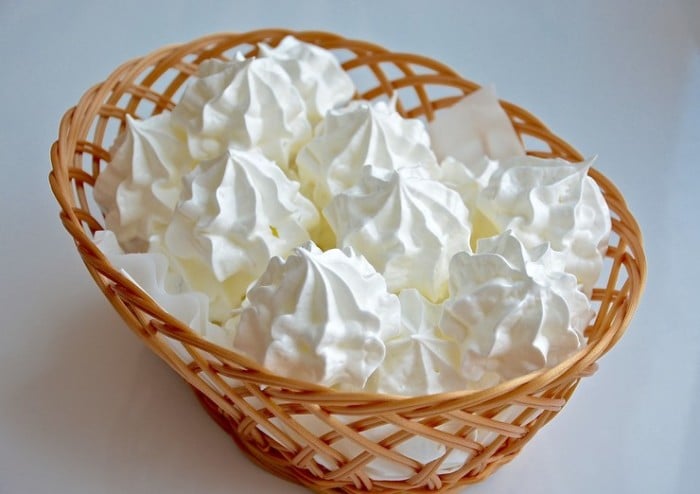
What sweets can a nursing mother eat if her child has diathesis?
Diathesis is a hereditary predisposition of the body, usually in childhood, to the occurrence of pathological reactions on the skin. It can be a consequence not only of allergies, as a large number of women believe, but also of acid metabolism disorders, respiratory infections, convulsions, etc. In most cases, eating sweets does not affect the occurrence of the reaction. But if it is determined that the cause of the problem is still an allergy, a nursing woman is prohibited from eating sweets until the allergen is identified.
Harmful properties of sugar
- Inhibition of beneficial bacteria;
- Putrefactive and fermentation processes in the intestines and stomach;
- Flatulence and digestive disorders, stool disorders and severe colic;
- The occurrence of excess weight and even obesity;
- A negative effect on the condition of nerve cells, children become irritable and overly excited, they can show aggression and hysteria;
- Violation of material and mineral metabolism. If sugar is consumed in a minimal amount, it has a positive effect on the absorption of certain minerals and vitamins. If it is in excess, on the contrary, it washes away calcium and provokes a deficiency of vitamin B;
- Deterioration of the condition of teeth and gums, caries, formation of malocclusion. Due to an excess of sugar in the product’s diet, the baby loses its baby teeth early;
- Weakened immunity and decreased appetite. Children quickly get used to the sweet, pleasant taste and subsequently refuse their usual food, ordinary water and unsweetened drinks;
- Increased blood sugar levels, development of diabetes mellitus;
- Diathesis, increased allergic reaction to other products, rashes and redness on the skin.
Doctor Komarovsky's opinion
Dr. Komarovsky is an adherent of the theory that a nursing woman should not give up any products with a natural composition. Products containing chemical additives and alcohol are prohibited. The mother's diet should not be significantly limited, since breastfeeding is not a disease. A woman’s nutrition at this time should be complete. It is also not forbidden to eat sweets. It is important to gradually introduce them into the diet and monitor the child’s reaction. If he has symptoms of allergies or tummy problems, then he needs to limit the presence of a specific product, but not all sweets.
Meringue recipe for nursing
- Eggs – 3 pieces;
- Powdered sugar – 180 grams.
Separate the whites from the yolks and beat at low speed. When they start to foam, increase the speed and continue whisking until you get a white thick foam. Slowly add powdered sugar into the protein mixture, continuing to beat. If you don't have powdered sugar, you can take regular sugar and grind it in a coffee grinder. Whole grains are difficult to beat completely.
Add powdered sugar or sugar only at the end! Add in portions, continuing to beat. Mix the resulting mixture manually with a spoon and beat again at high speed.
Line a baking tray with baking paper and form meringue on top. Bake for 1-1.5 hours depending on the size at a temperature of 100 degrees. The smaller the cake, the faster it will cook. The finished dessert will easily separate from the parchment paper.
After cooking, leave the meringue in the turned off oven for a few minutes. You can add vanillin, lemon juice, cinnamon, coconut, chopped nuts or cocoa to the basic recipe.
Reviews from those who ate sweets while breastfeeding
Marya, 25 years old
I constantly ate sweets during breastfeeding. I tried not to eat cakes or fatty pies, but I always ate regular dry cookies, dark chocolate and similar foods. The baby had no reaction. If there was, I wouldn't eat it.
Rita, 32 years old
I tried not to eat sweets. I ate a little dried fruit, candied fruit, and dark chocolate if I couldn’t bear it. I was very afraid that the baby would have allergies. Fortunately, everything went well.
Yana, 29 years old
I'm one of those unfortunate mothers who couldn't do anything. At most I could eat dried fruits from apples or prunes. The baby had a reaction on his cheeks to everything else sweet. That’s why I stopped breastfeeding at 6.5 months. Well, I couldn’t sit on oatmeal, buckwheat and beef anymore.
Harm
A lot of sweets in the diet of a child and a nursing mother negatively affects both organisms:
- Excess negatively affects the intestinal microflora, causing gas formation, fermentation, and disrupts stool. For a child, this has a detrimental effect on the intestines, which will further affect the ability of digestion.
- Another negative factor is the high calorie content - the baby will eat a smaller amount of sweetened porridge, but there will be little satiety, and he will want to eat earlier. Such nutrition will lead to excess weight, energy will not be spent on vigorous activity in a timely manner, and its excess will accumulate in the form of fat reserves.
- For the nervous system. If for a mother this is a great way to cope with depression and cheer herself up, then for an infant, sweets become stimulants and irritants. As a result, the baby falls asleep poorly and has restless sleep. In special situations, hysteria and aggression may be added.
- Also, an excess of sweets has a bad effect on the absorption of vitamins. This leads to the development of caries, washes out calcium - which leads to early loss of baby teeth.
- For immunity, it decreases and becomes weakened.
We recommend reading: Is it possible to eat avocado during breastfeeding: benefits, harm, recipes
Allergy to sugar
The child’s body may react negatively to the glucose contained in sugar. Your child may experience redness and peeling in the following areas:
- in the groin;
- on the cheeks;
- on the elbows.
The child’s body may react negatively to the glucose contained in sugar
A negative reaction to sugar in an infant can manifest itself in the form of colic. When they occur, the child pulls his legs to his chest and behaves restlessly.
Sweet recipes for nursing mothers
There is nothing healthier than natural homemade products, so sweets made from them are the safest for nursing mothers. Preparation does not take much time, and you can be sure of the quality of such delicacies.
Recipe for baked goods allowed in the first month
Baking in the first month is not recommended for a nursing mother. It is best to prepare biscuits from baked goods during this period.
Compound:
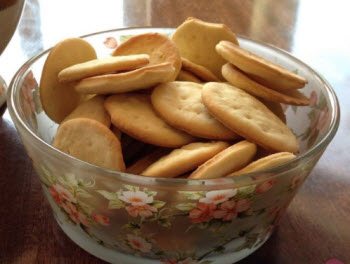
Galette cookies are the best option for baking allowed in the first month after the birth of the baby.
- Quail eggs - 2 pcs. (or 1/2 chicken, but it is an allergen).
- Milk - 1 tbsp. l.
- Sugar - 1 tbsp. l.
- Flour - 80 g.
- Vegetable oil - 1 tbsp. l.
- Soda - ¼ tsp.
- Salt - a pinch.
Preparation:
- Beat sugar and egg.
- Add butter and milk.
- Mix dry ingredients and add to wet mixture.
- Line a baking sheet with parchment and grease with oil.
- Form cookies and bake at 220 degrees for 5-10 minutes.
Recipe for PP dessert made from cottage cheese in a slow cooker for a nursing mother with photo
If you have a slow cooker, you can cook sweets in it. An excellent dessert option could be cottage cheese casserole.
Compound:
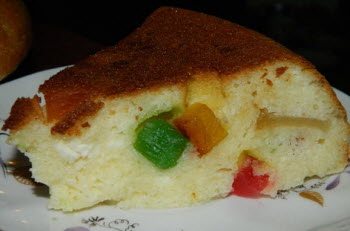
PP casserole of cottage cheese with candied fruits in a slow cooker is perfect as a dessert for a nursing mother.
- Cottage cheese - 0.5 kg.
- Eggs - 3 pieces.
- Sugar - 100 g.
- Baking powder - 2 tsp.
- Semolina - 100 g.
- Vanillin - to taste.
- Candied fruits and dried fruits - to taste.
Preparation:
- Beat eggs with sugar.
- Add semolina, cottage cheese, baking powder, vanillin.
- Let stand for 15 minutes.
- Pour boiling water over dried fruits to soften.
- Add candied fruits and dried fruits to the cottage cheese.
- Set the multicooker to baking mode for 50 minutes.
Homemade cottage cheese cake
Since cottage cheese is an excellent baking base for nursing mothers, you can make not only a casserole, but also a cupcake from it.
Compound:

Homemade cottage cheese cake for a nursing mother.
- Cottage cheese - 200 g.
- Butter - 2 tbsp. l.
- Sour cream - 2 tbsp. l.
- Flour - 1 cup.
- Eggs - 2 pcs.
- Sugar - 1 cup (or less, to taste).
- Soda - 0.5 tsp.
- Salt - a pinch.
Preparation:
- Beat eggs with sugar.
- Add the remaining ingredients and knead the dough.
- Bake in an oven preheated to 200 degrees for 30–40 minutes.
There is also a recipe for curd cheesecake on my culinary blog. If your diet includes chicken eggs, cottage cheese, and sour cream, then you can prepare this wonderful, tasty and beautiful dessert at home. For a step-by-step recipe with photos, see the article “How to make a classic cheesecake with cottage cheese at home?”
Recipe for making meringue cake for a nursing mother at home
Finding store-bought meringue with a natural composition is extremely difficult. It is best to prepare it yourself. Moreover, it is very easy to do.
Compound:
- Egg whites - 4 pieces.
- Powdered sugar - 150 g.
- Lemon juice - 1 tsp. (you can do without it).
Preparation:
- Turn on the oven at 100–120 degrees.
- Prepare a baking sheet. Cover with parchment and grease with oil.
- Separate the whites from the yolks so that the latter do not get into the whites.
- Pour the egg whites into a dry bowl and beat with a mixer until stiff peaks of shiny foam form, gradually adding powdered sugar. To check readiness, turn the bowl over. If the whites do not flow, the mixture is ready.
- You can add lemon juice and beat for a few more minutes. This will make the foam more durable.
- Place the whites on a baking sheet and place in the oven for about 2 hours. When the meringue is dry, turn off the oven and let it sit there until it cools.
Vegetables
After two weeks, new foods may appear in the young mother’s diet. For example, seasonal vegetables. Zucchini, tomatoes, potatoes, cucumbers, cauliflower, broccoli and even celery in small quantities.
Vegetables are rich in vitamins and help reduce swelling, the risk of osteoporosis and anemia. Many parents are interested in whether sweet peppers can be consumed while breastfeeding. Yes, this vegetable contains vitamin A, potassium and rutin, which strengthens capillaries. Opt for yellow or green sweet peppers.
As for the cooking method, vegetables can be eaten raw, baked or boiled.
Do not experiment with onions, garlic and white cabbage.
